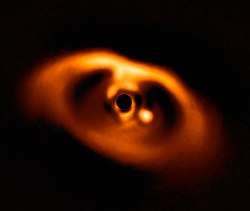K2-19
K2-19 is a K-type main sequence star[4] that is magnetically active, and has a light curve that exhibits variations in brightness of ~1%.[8] Three confirmed transiting exoplanets are known to orbit this star.
| Observation data Epoch J2000 Equinox J2000 | |
|---|---|
| Constellation | Virgo[1] |
| Right ascension | 11h 39m 50.4804s[2] |
| Declination | +00° 36′ 12.8773″[2] |
| Apparent magnitude (V) | 13.002±0.009[3] |
| Characteristics | |
| Spectral type | K0 V[4] |
| Apparent magnitude (J) | 11.596±0.024[5] |
| Apparent magnitude (H) | 11.208±0.022[5] |
| Apparent magnitude (K) | 11.161±0.026[5] |
| Variable type | Planetary transit variable[6] |
| Astrometry | |
| Proper motion (μ) | RA: −18.788±0.104[2] mas/yr Dec.: 4.415±0.066[2] mas/yr |
| Parallax (π) | 3.4230 ± 0.0658[2] mas |
| Distance | 950 ± 20 ly (292 ± 6 pc) |
| Details[4] | |
| Mass | 0.918±0.064 M☉ |
| Radius | 0.881±0.111 R☉ |
| Surface gravity (log g) | 4.50±0.10 cgs |
| Temperature | 5250±70 K |
| Metallicity [Fe/H] | 0.10±0.05 dex |
| Rotation | 20.54±0.30 d |
| Rotational velocity (v sin i) | 3.00±0.50 km/s |
| Other designations | |
| Database references | |
| SIMBAD | data |
Planetary system
Discovery
The two outer planets were reported as planet candidates during analysis of data from Campaign 1 of the Kepler spacecrafts K2 extended mission.[9] Both planets were confirmed by David J. Armstrong and collaborators, who used ground-based telescopes to detect additional transits and measure hour-long transit-timing variations for K2-19b.[6] They were independently validated along with 20 other planets by Benjamin T. Montet and team.[10]
K2-19d was first reported as a planet candidate during a search for candidates from the first year of the K2 Mission[11] and was later validated by Sinukoff et al.[8]
Characteristics
K2-19 has a planetary system with three known planets, of which the two larger ones, K2-19b and K2-19c, are close to the 3:2 mean motion resonance. All three planets orbit closer to their star than the planet Mercury does to the Sun.[4][12]
| Companion (in order from star) |
Mass | Semimajor axis (AU) |
Orbital period (days) |
Eccentricity | Inclination | Radius |
|---|---|---|---|---|---|---|
| K2-19b | 54.4±8.9 M⊕ | 0.0762±0.0022 | 7.91951+0.00040 −0.00012 |
0.023+0.240 −0.020 |
88.87+0.16 −0.60° |
7.16±0.91 R⊕ |
| K2-19c | 7.5+3.0 −1.4 M⊕ |
0.1001±0.0029 | 11.9066+0.0021 −0.0014 |
0.183+0.283 −0.003 |
88.92+0.14 −0.41° |
4.34±0.55 R⊕ |
| K2-19d | ? M⊕ | 0.0344±0.0006 | 2.50856±0.00041 | ? | 85.83+2.97 −4.74° |
1.14±0.13 R⊕ |
References
- Roman, Nancy G. (1987). "Identification of a Constellation From a Position". Publications of the Astronomical Society of the Pacific. 99 (617): 695–699. Bibcode:1987PASP...99..695R. doi:10.1086/132034. Vizier query form
- Brown, A. G. A.; et al. (Gaia collaboration) (August 2018). "Gaia Data Release 2: Summary of the contents and survey properties". Astronomy & Astrophysics. 616. A1. arXiv:1804.09365. Bibcode:2018A&A...616A...1G. doi:10.1051/0004-6361/201833051. Gaia DR2 record for this source at VizieR.
- Henden, A. A.; et al. (2016). "VizieR Online Data Catalog: AAVSO Photometric All Sky Survey (APASS) DR9 (Henden+, 2016)". VizieR On-line Data Catalog: II/336. Originally Published in: 2015AAS...22533616H. 2336. Bibcode:2016yCat.2336....0H.Vizier catalog entry
- Nespral, D.; et al. (2017). "Mass determination of K2-19b and K2-19c from radial velocities and transit timing variations". Astronomy and Astrophysics. 601. A128. arXiv:1604.01265. Bibcode:2017A&A...601A.128N. doi:10.1051/0004-6361/201628639.
- Skrutskie, M. F.; et al. (2006). "The Two Micron All Sky Survey (2MASS)". The Astronomical Journal. 131 (2): 1163–1183. Bibcode:2006AJ....131.1163S. doi:10.1086/498708.Vizier catalog entry
- Armstrong, David J.; et al. (2015). "One of the closest exoplanet pairs to the 3:2 mean motion resonance: K2-19b and c". Astronomy and Astrophysics. 582. A33. arXiv:1503.00692. Bibcode:2015A&A...582A..33A. doi:10.1051/0004-6361/201526008.
- "K2-19". SIMBAD. Centre de données astronomiques de Strasbourg. Retrieved 2018-12-31.
- Sinukoff, Evan; et al. (2016). "Eleven Multiplanet Systems From K2 Campaigns 1 and 2 and the Masses of Two Hot Super-Earths". The Astrophysical Journal. 827 (1). 78. arXiv:1511.09213. Bibcode:2016ApJ...827...78S. doi:10.3847/0004-637X/827/1/78.
- Foreman-Mackey, Daniel; et al. (2015). "A Systematic Search for Transiting Planets in the K2 Data". The Astrophysical Journal. 806 (2). 215. arXiv:1502.04715. Bibcode:2015ApJ...806..215F. doi:10.1088/0004-637X/806/2/215.
- Montet, Benjamin T.; et al. (2015). "Stellar and Planetary Properties of K2 Campaign 1 Candidates and Validation of 17 Planets, Including a Planet Receiving Earth-like Insolation". The Astrophysical Journal. 809 (1). 25. arXiv:1503.07866. Bibcode:2015ApJ...809...25M. doi:10.1088/0004-637X/809/1/25.
- Vanderburg, Andrew; et al. (2016). "Planetary Candidates from the First Year of the K2 Mission". The Astrophysical Journal Supplement Series. 222 (1). 14. arXiv:1511.07820. Bibcode:2016ApJS..222...14V. doi:10.3847/0067-0049/222/1/14.
- Williams, David R. (2018-09-27). "Mercury Fact Sheet". NASA. Retrieved 2019-01-12.
- Barros, S. C. C.; et al. (2015). "Photodynamical mass determination of the multiplanetary system K2-19". Monthly Notices of the Royal Astronomical Society. 454 (4): 4267–4276. arXiv:1510.01047. Bibcode:2015MNRAS.454.4267B. doi:10.1093/mnras/stv2271.
